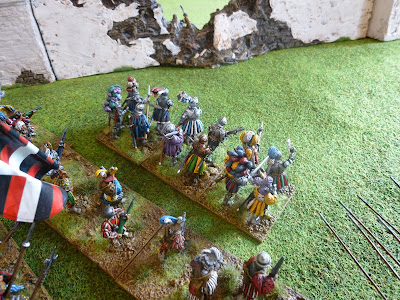
This is the first unit for the army, or should I say peasant band, I am currently working on. 71 peasants for the German Peasant's War of 1524-1525. The release of the excellent new miniatures by Steel Fist,
https://www.steelfistminiatures.com/product-category/italian-wars-1494-1538/, meant that I could not resist building up a force for the collection. The Steel Fist figures are fantastic sculpts with loads of character that really capture the feel of the early 16th century and match contemporary images of the German Peasants. Whilst the unit pictured is formed predominantly of Steel Fist figures suitable figures from other manufacturers have been added, these being Wargames Foundry, Artizan and even a couple of old Grenadier miniatures and an old Pro Gloria figure, now sold by Warlord. Some of the figures have been converted and head swapped for variation or to bring them more into the 1500s. They have all been armed with a wide variety of different weapons and farm implements from loads of different manufacturers. The banners shown in the pictures are all from Pete's superb range of flags:
https://www.ebay.co.uk/usr/petes_flags.
 |
| A unit of German peasants prepares to fight under a crucifix and banner showing the "bundschuh". |
 |
| 28mm German Peasant's Wars miniatures. |
 |
| A unit of German peasants made up of Steel Fist, Artizan, Foundry, Warlord and Grenadier miniatures. |
 |
| 28mm 16th century peasants. |
 |
| German Peasant's War miniatures. |
 |
| The figures carry an assortment of weaponry from improvised agricultural implements to bills, halberds, spears and ahlspiess. |
 |
| The peasant unit from behind. |
 |
| One of the command bases with the bundschuh banner. |
 |
| Another command base with the peasants fighting under a wooden crucifix. The crucifix is from Essex Miniatures. |
 |
| An example of one of the peasant bases. |
When working on this unit I wanted a versatile set of figures that could be used for German Peasant's War games but also as Tudor rebels and as militias in sieges. As such the figures have been based in a way that means some of the better armed troops, those with more armour and better weapons, such as halberds, bills, ahlspiess and spears, have been based together whilst those with more improvised weapons and less armour have been based together to represent less militarily prepared peasants. This means I can take some of the bases out of the unit and use them for other armies as shown in the photo below where the better armed troops are representing French infantry from the 1520s.
 |
| Some of the bases serve well as militia troops. Here they represent French infantry for the 1510s and 1520s. |
 |
| Other bases are more suitable for completely unamoured peasant levies as shown by these bases. |
 |
| 28mm poorly armed peasants. |
The peasant bands that formed during the German Peasant's War of the mid 1520s had landsknecht in their ranks, after all the bands of landsknecht mercenaries were formed from the German population of the time. They followed the organisation of landsknecht formations closely and appointed officers using the same titles such as
feldweibel and
rottmeister. Some of the Steel Fist sculpts are wearing elements of landsknecht dress to reflect this. The pictures below show the new unit mixed with some bases of landsknecht halberdiers. For German Peasant's War scenarios this is how I intend to field the figures, a mix that includes some landsknecht and some peasant bases. I considered mixing in landsknecht figures with some of the peasants on the bases but I think the method below works well and this means I can also use the peasants for different types of scenarios where landsknecht were not in their ranks.
 |
| During the German Peasants War many of the peasant bands had landsknecht in their ranks. Here the peasant bases are mixed with those of landsknechts. Note the "robber knight" on the right of the photo who has been persuaded to join the peasants. |
 |
| Peasants and landsknecht for the German Peasant's War. |
 |
| 28mm German peasants and landsknecht. |
I am also keen to use these figures to game Tudor rebellions. At a push they can work for anything from the Battle of Blackheath in 1497 through to the 1549 rebellions. For the 1549 rebellions, Kett's in Norfolk and The Prayer Book rebellion in Devon and Cornwall, I will mix in some bases of Assault Group figures. The Assault Group have miniatures that are specifically for the 1549 rebellions and would help bring the unit into the mid Tudor period.





























